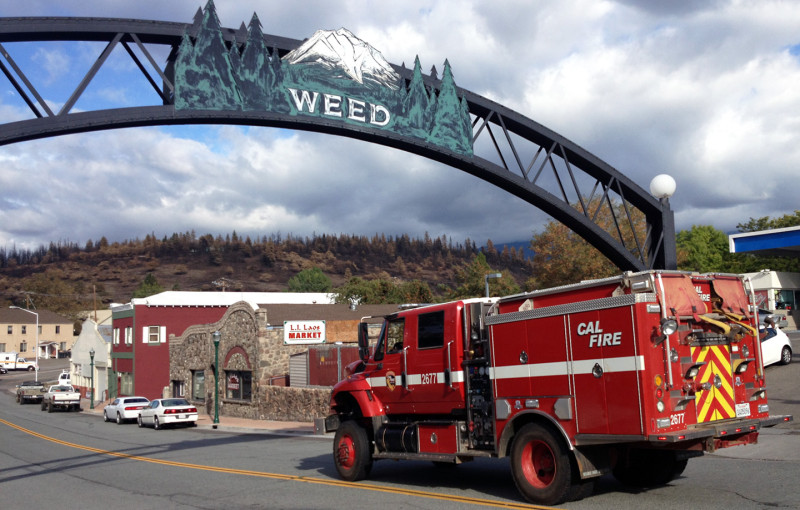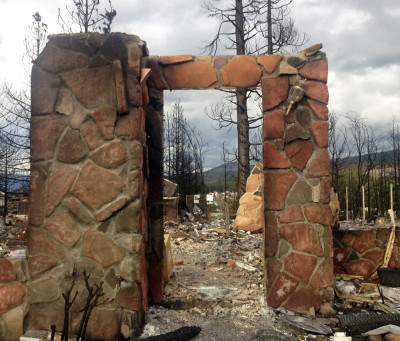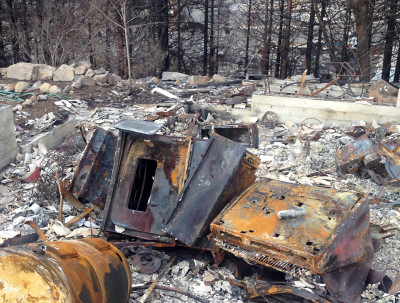After Fire, Weed Residents Wonder If Full Recovery is Possible

Depending on whom you ask in Weed, it will take many months or years for things to get back to normal -- or maybe it just won't ever be the same. On Sept. 15, a wildfire raced through the town, burning more than 140 homes, two churches, a library and a community center. Another 90 houses were damaged, along with the lumber mill that is Weed's largest private employer. Officials estimate some 750 people have been displaced in the town of not quite 3,000.
About 285 road miles north of San Francisco on Interstate 5, Weed greets visitors with kitschy tourist shops riffing on the town's name. "Enjoy Weed," a tie-dye shirt suggests, not far from the "I (Heart) Weed" lighters. Postcards display the snow on nearby Mount Shasta in beautiful crepuscular pinks and purples, and a neon sign in the window of the Hi-Lo Cafe promises homemade pie to the road-weary families and bikers who stop in.
Around back is a motel, where waitress Gail Breshears stayed for 10 days after she lost nearly everything she owned to the blaze. Physically intact but "emotionally fried," when asked how long it might take her to get back to normal, she says maybe never, then asks, "What is normal?"
That sentiment is common around town. While Tony Mazzei still has a house, a workshop burned up with all his tools inside, potentially forcing the longtime handyman into full retirement. He also lost a couple of classic cars to the fire.
"I bought it brand-new when I was 18 years old --'65 GTO," Mazzei says. "And my dad bought this 1950 Dodge brand-new --in 1950 -- and I restored it. So they're both gone and I can't get 'em back anymore."
Even if he could replace them, Mazzei says, the cars he knew all his life are gone.

Weed has received an outpouring of help, including clothing, household goods and tools from around the country. At the Weed Church of Christ, volunteer Kenneth Shaffer says they've given out all manner of supplies (they ran out of wheelbarrows) along with dozens of heavy boxes of food and toiletries sent from Nashville, Tennessee.
While folks in Weed say they're grateful, in some ways managing so much generosity has rippled into its own set of problems. At a meeting of about 40 resident in a church basement, officials said they'd received more donated pajamas and sweaters than they knew what to do with. Mayor Bob Hall described it as enough clothing to fill two gymnasiums 8 feet high.
Then there's the more long-term problem of housing. Among the hundreds of people who've been displaced, some are in a hotel while others stay with friends or family. City Administrator Ron Stock says officials are looking into places with room for trailers, where a few residents may end up spending the winter.
A couple of factors make rebuilding homes complicated. For one, many were built in the old logging town as company homes when asbestos and lead paint were commonplace. Cleanup is too hazardous to leave to volunteers, and in some cases could require removing even the burned home's foundation and a layer of earth to make sure no toxic heavy metals are left behind. Stock says the cost to haul out so much waste is on the order of $4 million -- a tab the state will pick up.
Another problem in an area near the lumber mill, known as Angel Valley, is that the old houses were tiny, often around 900 square feet, and on tiny lots that don't mesh neatly with modern requirements for homes set back on the lot, built with garages and so on. Stock says that on the one hand, there are safety concerns with rebuilding the neighborhood as it was, with homes packed in densely, because it allows fires to easily spread. On the other hand, homeowners may receive an insurance check and find it's not enough money to rebuild a house conforming to modern standards.

Other residents -- renters -- likely had little if any insurance for what they lost. Stock, who worked through the aftermath of several hurricanes as a city administrator in Florida, says some of the displaced people might just not come back.
One crucial resident that's not going anywhere is the Roseburg lumber mill, which slices trees into thin ribbons that are glued together to make plywood. It's Weed's largest private employer, second only to the school system for jobs, with more than 100 workers.
After the mill was damaged in the fire, Roseburg quickly transferred about 60 employees to another facility in Oregon so they could keep working. Dozens more are hustling to get the plant back up and running -- hopefully in time for Thanksgiving.
